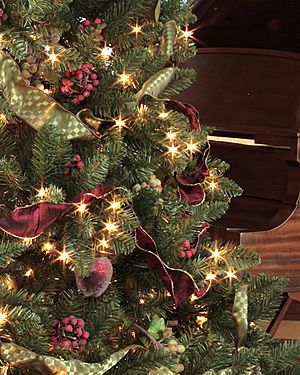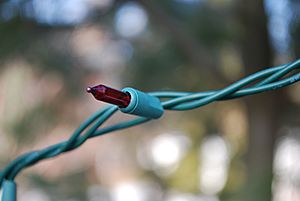Pre-lit tree facts for kids
A pre-lit tree is a special type of artificial Christmas tree that already has Christmas lights built into its branches. This means you don't have to spend time stringing lights yourself! The lights are usually woven into the branches and can't be taken off.
You can buy these trees in a few ways. Sometimes, you get a kit to put the tree together yourself and then just plug it in. Other times, the store might assemble it for you. Pre-lit trees can have different kinds of lights, like classic mini bulbs, bright LED lights, or even cool fiber-optic lights. Bigger trees often use traditional bulb strands, while smaller ones might have fiber-optic branches. More expensive trees often feature energy-saving LED lights. These trees are considered electrical products because they use electricity.

Contents
History of Christmas Tree Lights
For a long time, people used real candles to light up their Christmas trees. But this was quite tricky and very dangerous! Candles could easily start a fire, so someone always had to watch the tree carefully. People even kept a bucket of water nearby, just in case. Candle wax was also expensive. Later, some people used small lamps made from nutshells filled with oil and a wick. More fancy lamps were made from colored glass.
A new type of candle holder, called a counterbalance holder, helped keep candles upright. But even with these improvements, trees with candles were still a fire risk.
The Invention of Electric Lights
The invention of electric lights changed Christmas trees forever! In 1882, an inventor named Edward Hibberd Johnson, who worked for Thomas Edison, found a way to wrap tiny electric lights in colorful paper. These lights, strung on a tree, were the very first version of the Christmas lights we know today. However, electric Christmas tree lights were still new and experimental throughout the 1880s.
Smaller, miniature Christmas lights were first created in 1895 by Ralph E. Morris. He worked for a telephone company and got the idea from the tiny bulbs he saw on telephone switchboards. Even so, many Americans didn't trust electric lights in the early 1900s, and candles were still common. The first electric Christmas tree lights were simply small night-lights connected together. When companies like General Electric started selling Christmas lights, they quickly became very popular.
The Rise of Pre-Lit Trees
In the early 1990s, a company called Boto (which was once the world's largest maker of artificial Christmas trees) started making the first pre-lit trees. They supplied these trees to large stores. Thanks to new technology, pre-lit trees are now much easier to put together and look very realistic.
Safety of Pre-Lit Trees
It's important to be aware of safety when using holiday lights and decorations. Each year, many people visit hospitals because of injuries related to holiday lights or decorations. Also, Christmas trees can sometimes cause fires. Most of these fires happen with real Christmas trees. Artificial trees are usually safer because they are made with fire-resistant plastics.
However, pre-lit trees can still have some risks compared to artificial trees without lights. Because of this, there have been recalls in the past to make sure these products are safe for everyone.
Common Safety Concerns
- Fire and Shock Hazards: Sometimes, electrical cords or parts of the lights can get too hot or even melt. This can cause a fire or an electric shock. For example, some trees were recalled because their extension cords overheated. Others had parts that could get too hot and catch fire. It's always important to make sure all electrical connections are fully plugged in.
- Toxic Substances: Some parts of the lights on pre-lit trees might contain very small amounts of certain metals like lead, mercury, cadmium, or chromium. However, strict safety rules help control these substances.
Safety Standards and Rules
Because pre-lit trees are electrical products, they must follow special laws and safety rules. These rules are set by different organizations around the world to make sure products are safe for people to use. Some of these important safety groups include:
- UL in the United States
- CSA in Canada
- AS/NZS in Australia and New Zealand
- GS in Germany
- BS in the United Kingdom
- RoHS in the European Union, which limits certain harmful substances.
These standards help ensure that pre-lit trees are made safely and reduce risks.
Storing Your Pre-Lit Tree
Storing a pre-lit tree properly is important because the lights are attached to the branches. There are a few good ways to store these trees.
Using the Original Box
The most common way to store a pre-lit tree is in the box it came in. This box is usually designed to fit the tree perfectly, making it easier to move and keep safe. Often, these boxes are a bit oversized to protect the tree during shipping and storage.
Using Storage Bags
Many companies also offer special bags for storing pre-lit trees. These bags can be strapped around the tree. You pull the tree branches upwards, place the bag underneath, and then pull the bag up over the tree using its handles. Once the tree is in the bag, you can hang it up by the handles for easy storage.


